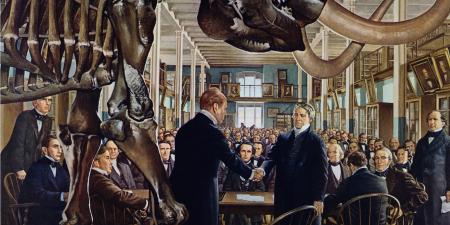In March 2007, state senators in South Carolina introduced legislation intended to address a tremendous problem facing the medical community. According to Senate Bill 480, the South Carolina Department of Corrections would be given the authority to reduce the length of a prisoner’s incarceration period by as much as 6 months should he or she be willing to donate bone marrow or a kidney [1]. South Carolina’s Senate Corrections and Penology Subcommittee approved the bill [1]. Democratic Senator Ralph Anderson, the bill’s chief sponsor, stated that the legislation could be useful in beginning to address the nation’s desperate need for viable kidneys and bone marrow, given the existing difficulties in persuading the American public to donate and that, if swayed, prisoners would most likely be happy to know that they had contributed to saving lives [2]. Proponents of the bill noted that it contained revisions to ensure that all donations were voluntary and that the state would ultimately determine which volunteers could and could not donate [3].
The bill did not proceed further in the legislative process. The federal law governing organ donation prohibits the exchange of human organs for “valuable consideration” [4], meaning anything of value, and the reduction of a prisoner’s sentence by up to 180 days falls squarely within this statutory definition [5]. Critics of the proposed bill also decried the program as unethical and potentially dangerous. Lawrence Gostin of the Georgetown University Law Center stated that “for a prisoner to actually benefit from giving up an organ violates every ethical value I’m aware of” [3], while Jonathan Groner of The Ohio State University College of Medicine and Public Health commented on the higher incidence of HIV/AIDS, hepatitis, and tuberculosis in prisoner populations, saying “I don’t think I would want a loved one to receive a ‘prison kidney’” [2].
A less criticized (and less publicized) aspect of the program, however, was its racial undertones. In 2007, 65 percent of South Carolina’s approximately 30,000 inmates were African American [6]. Senator Anderson, who is African American, proposed the prison donation program to address the historically low living donation rates among black men and women [6].
Efforts to meet the demand for organs have long had disproportionate effects on members of particular races, not only because of disparate levels of need for transplants but because of the way our donation system works.
The Altruistic Model
The current legal framework that determines how organs and tissues are obtained is guided exclusively by one principle: altruistic giving. For the last 30 years, Americans in need of organs or tissues have had to rely on the generosity of family, friends, and strangers to give of their bodies in life or in death.
The Uniform Anatomical Gift Act (UAGA) regulates the procurement of organs from cadaveric donors and establishes the legal and ethical guidelines for organ transplantation [7], all of which is based upon altruistic donation [8]. The original 1968 version of the UAGA did not specifically ban the sale of deceased-donor organs or discuss the matter of compensation, leaving the issue of incentives to case-by-case determinations at the state level [9]. In 1984, after the highly publicized actions of H. Barry Jacobs, a self-proclaimed organ broker who proposed creating organ markets that would buy and sell the kidneys of indigent populations from the US and the developing world [10], Congress enacted the National Organ Transplant Act (NOTA) to address the question of the compensation for organs and tissues directly [11]. Under NOTA, the buying and selling of organs is strictly prohibited—“It shall be unlawful for any person to knowingly acquire, receive, or otherwise transfer any human organ for valuable consideration for use in human transplantation if the transfer affects interstate commerce” [4]—with the penalties for this offense being $50,000, imprisonment of not more than five years, or both [12]. This prohibition was incorporated into the 1987 revision of the UAGA and remains in the current version, which has been adopted by 45 states, Washington, DC, and the US Virgin islands [13].
The Organ Shortage
The altruistic model for organ and tissue donation, though admirable in its attempts to protect the populace from being exploited for their organs, has proven insufficient in developing a supply of organs and tissue that can be effectively and efficiently used. There are not enough organ donors to meet demand. This has multivalent racial implications. The organ shortage disproportionately affects members of some minority groups, in which there are higher rates of need for organs. Conversely, one reason for the organ shortage is that donation rates are particularly low among racial and ethnic minority groups, whose members have been historically less willing to donate their body parts than Caucasians [14]. Furthermore, attempts to increase the organ supply have ended up disproportionately targeting members of these same groups.
There are several hypothesized reasons for the low rate of organ donation among members of minority populations. One may be a lack of personal knowledge of a friend, family member, or acquaintance who has donated an organ, which might make people less likely to consider donating themselves: in one national study, African American respondents were three times less likely to report knowing a person who had donated organs or tissues than Caucasian respondents [15].Other reported reasons for bypassing donation are the influence of religious or faith-based objections to donating tissues or organs [16] and miscommunications between potential donors and their families about the intent to donate [17].
One of the most significant barriers to donation, especially in the African-American community, has been a distrust of the medical establishment [15]. One often-cited reason for this pervasive distrust is the looming shadow of atrocities like the Tuskegee syphilis study [18]. Scandals of that kind can engender fears that, if one has expressed willingness to donate organs, one will not receive needed medical care, so that one’s death may be hastened or even that one’s organs may be taken before death [15].
A Less Than Successful Alternative to Altruism: Presumed Consent
One widely used legal mechanism for increasing the supply of cadaveric organs seems to substantiate fears of unequal or exploitative treatment in the organ donation arena. This mechanism, which has been pursued for several decades, is enactment of “presumed consent” laws, where a state puts into place an opt-out donation process for certain people: those whose bodies come before coroners or medical examiners when there is no known objection by the deceased or by a family member [19]. Presumed consent laws have been implemented primarily for the authorized extraction of corneas, whole eyes, and other bodily tissues that can be harvested in a less invasive manner [20]. These laws first appeared in the 1960s as a response to shortages of organs and tissues needed for transplantation and other therapeutic purposes [19]. In some states that enacted presumed consent laws, corneal transplants increased substantially from a few hundred per year to more than a thousand transplants per year a decade later, and some states even ended up with more corneas that they could hope to transplant [21].
Although these laws appear to be neutral, in that they do not name any specific population, in practice, they disproportionately affect African Americans and Latinos [22]. An investigation by the Los Angeles Times into presumed consent laws and cornea removal unearthed startling statistics, reporting that 72 percent of autopsies were performed on homicide victims, with accident victims making up the second largest group of autopsies [23]. Especially in inner cities, young black and Latino men and women are at a greater risk for being the victims of violent crime, raising the chance that their bodies will come before coroners or medical examiners [22]. Indeed, 80 percent of those autopsied, meaning that their consent for tissue donation was presumed, were African American and Latino [23]. Only 16 percent of those autopsied were Caucasian [23]. As Michele Goodwin notes, “based on trends of death, gang violence, drug culture, and a host of other social problems that seem more concentrated in urban environments, it is not unforeseeable that legislative consent would disproportionately affect people of color” [22].
Presumed consent laws have increasingly fallen out of favor in the last two decades, not only because of their unequal impact on members of racial and ethnic minorities, but also because of objections by the families of the deceased, who have continuously challenged these laws in and out of court to prevent their loved ones’ tissues from being taken [19]. Presumed consent provisions were cut from the 2006 version of the UAGA, and many states subsequently followed this change in law [19].
Conclusion
The system in place for allocating organs and tissues in the United States has faltered. Too many sick patients have little-to-no access to the precious biological materials that can prolong their lives and end their suffering, and an overwhelming percentage of those patients are members of racial and ethnic minority groups. The current organ and tissue donation framework relies on altruistic giving, and many critics have called for reforms that create incentives for giving through monetary compensation to donors or to donors’ families [24]. Increasing the supply of voluntarily provided organs (whether donated or sold) might be a more equitable alternative to presuming the consent of the already marginalized—but not if the very same people end up disproportionately selling their organs [25]. Whatever form the necessary legal changes take within the organ donation and transplantation arena, they will have to carefully balance the benefits and burdens they bestow on everyone and do their best to alleviate the current injustices.
References
-
Adcox S. SC may cut jail time for organ donors. Associated Press. March 8, 2007. http://newsok.com/s.c.-may-cut-jail-time-for-organ-donorsarticle/3023837. Accessed April 15, 2014.
-
Stone G. Give a kidney to shorten your prison sentence? ABCNews.com. March 9, 2007. http://abcnews.go.com/US/LegalCenter/story?id=2940289&page=1. Accessed April 15, 2014.
-
Jarvie J. Inmates could trade an organ for an early out. Los Angeles Times. March 9, 2007. http://articles.latimes.com/2007/mar/09/nation/na-organs9. Accessed April 15, 2014.
-
Prohibition of Organ Purchases, 42 USC section 274e(a) (2014). http://uscode.house.gov/view.xhtml?req=granuleid:USC-prelim-title42-section274&num=0&edition=prelim. Accessed May 2, 2014.
-
Lee EC. Trading kidneys for prison time: when two contradictory legal traditions intersect, which one has the right-of-way? Univ of San Francisco Law Rev. 2009;43:507-555.
-
O’Reilly KB. Prisoner organ donation proposal worrisome. American Medical News. April 9, 2007. http://www.amednews.com/article/20070409/profession/304099964/6/. Accessed April 15, 2014.
-
Uniform Anatomical Gift Act, sections 3-23 (2006). http://www.uniformlaws.org/shared/docs/anatomical_gift/uaga_final_aug09.pdf. Accessed April 28, 2014.
- Goodwin M. Altruism’s limits: law, capacity, and organ commodification. Rutgers Law Rev. 2004;56(2):305-407.
-
Goodwin M. The veneer of altruism. Virtual Mentor. 2012;14(3):256-263. http://virtualmentor.ama-assn.org/2012/03/msoc1-1203.html. Accessed April 24, 2014.
-
Engel M. Va. doctor plans company to arrange sale of human kidneys. Washington Post. September 19, 1983: A9.
-
National Organ Transplant Act of 1984, Pub L No 98-507, 98 Stat 2339-48 (1984). http://history.nih.gov/research/downloads/PL98-507.pdf. Accessed April 28, 2014.
-
Prohibition of Organ Purchases, 42 USC section 274e(b) (2014). http://uscode.house.gov/view.xhtml?req=granuleid:USC-prelim-title42-section274&num=0&edition=prelim. Accessed May 2, 2014.
-
Uniform Law Commission. Anatomical Gift Act (2006) summary. http://www.uniformlaws.org/ActSummary.aspx?title=Anatomical%20Gift%20Act%20(2006). Accessed April 24, 2014.
- Goldberg DS, Halpern SD, Reese PP. Deceased organ donation consent rates among racial and ethnic minorities and older potential donors. Crit Care Med. 2013;41(2):496-505.
- Minniefield WJ, Yang J, Muti P. Differences in attitudes toward organ donation among African Americans and whites in the United States. J Natl Med Assoc. 2001;93(10):372-379.
-
Morgan M, Kenten C, Deedat S; Donate Programme Team. Attitudes to deceased organ donation and registration as a donor among minority ethnic groups in North America and the UK: a synthesis of quantitative and qualitative research. Ethn Health. 2013;18(4):367-390.
-
Daniels DE, Smith K, Parks-Thomas T, et al. Organ and tissue donation: are minorities willing to donate? Ann Transplant. 1998;3(2):22-24.
- Gamble VN. Under the shadow of Tuskegee: African Americans and health care. Am J Public Health. 1997;87(11):1773-1778.
- Orentlicher D. Presumed consent to organ donation: its rise and fall in the United States. Rutgers L Rev. 2009;61(2):295-331.
- Goodwin M. Empires of the flesh: tissue and organ taboos. Alabama Law Rev. 2009;60(5):1219-1248.
-
Goodwin M. Rethinking legislative consent law? DePaul J Health Care L. 2002;5(2):257-315.
-
Goodwin M. Deconstructing legislative consent law: organ taking, racial profiling and distributive justice. Virginia J Law Tech. 2001;(6):2. http://www.vjolt.net/vol6/issue1/v6i1a02-Goodwin.html. Accessed April 24, 2014.
-
Frammolino R. Harvest of corneas at morgue questioned. Los Angeles Times. November 2, 1997. http://articles.latimes.com/1997/nov/02/news/mn-49420. Accessed April 17, 2014.
-
Goodwin M. The organ donor taboo. Forbes. September 28, 2007. http://www.forbes.com/forbes/2007/1015/032.html. Accessed April 17, 2014.
- Kahn JP, Delmonico FL. The consequences of public policy to buy and sell organs for transplantation. Am J Transplantation. 2004;4(2):178-180.



